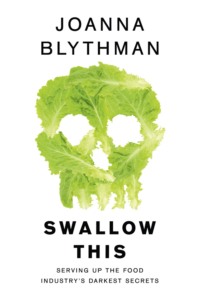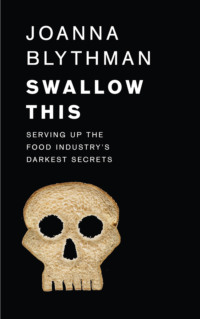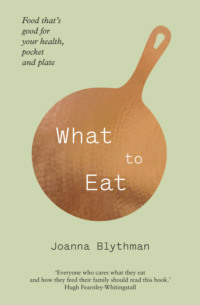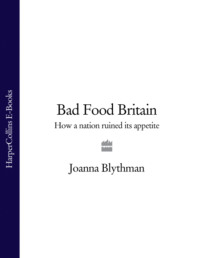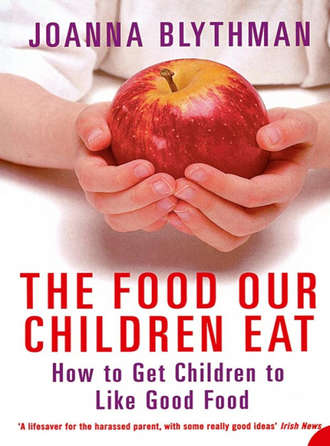
Полная версия
The Food Our Children Eat: How to Get Children to Like Good Food
Baby-food manufacturers assure parents that their products are ‘specially formulated for your baby’, but such foods would be more accurately described as ‘specially formulated to con parents into believing that they can’t feed children by themselves’. This hidden agenda, of course, is never made explicit.
Nowadays, manufacturers realise that they must pay lip service to the idea that their baby foods are not intended to replace home-prepared food and that they are just a safe, handy convenience for the ‘busy mum’. But by clever labelling, which first raises anxieties then appears to allay them, they implicitly perpetuate the false idea that parents somehow lack the nutritional knowledge to prepare baby food themselves. They undermine our confidence about feeding our babies on variations of the household food supply that we ourselves eat, even though this was, after all, the common-sense and highly practical way that parents fed their children until quite recently.
How does this work?
We start to make decisions about how our children will eat from day one. The first issue is whether to breastfeed or use formula milk in a bottle. On this one there is widespread agreement: try to breastfeed if you can but, failing that, it’s fine to fall back on formula milk.
When breastfeeding goes well, it is simple, natural and rewarding. There are no worries about sterilising teats and bottles, no tricky temperature judging, no need to work your way through the formula milks on sale to find the one your baby accepts.
When breastfeeding doesn’t work out, the routine preparation of formula and all that it entails can seem like light relief after sore nipples, frustration and a dissatisfied baby. Parents who actively choose formula milk or who just end up using it know that this milk has been specially formulated to be as similar to breast milk as possible. We have been told that it is not good enough simply to give our offspring any old milk, be that cow’s, goat’s, sheep’s or even soya, because in its standard form it has not been adapted for the sensitive digestive systems of human infants.
Such advice is, of course, sensible and accurate. If we can’t feed babies on nature’s intended breast milk, we must rely on commercial companies, their scientists and nutritionists, to devise formulas that give them all they need to grow and won’t upset them or spark off allergies. It’s a complicated business and we must leave it in the hands of the experts.
But thereafter, if we want our children to grow up to be adults who eat well – adults with wide-ranging tastes who enjoy food and self-select nutritious food – we need to draw a line under the food industry’s scientific ‘advice’. From the time that we introduce the first weaning foods, usually in that critical and often challenging time when our baby is four to six months old, we do not need to rely routinely on commercial baby foods any more than we need to employ a food taster to check that our food hasn’t been poisoned. Instead, we need to view all those little jars and packets with a healthy cynicism.
Why? Like formula milk, many weaning foods give the impression that there is something special about them, that they are foods devised by knowledgeable nutritionists and doctors. Obviously, manufacturers have a direct interest in fostering this impression. In 1998 the British baby-food market was worth almost £164,000 million, and it is growing each year. So food manufacturers make a lot of money supplying parents with foods they think they cannot make themselves.
But unlike formula milk, which is a carefully devised product, commercial baby foods are nothing special. Though there are a few high-quality exceptions, most commercial baby foods represent nothing more than bulk-bought ingredients that have been heavily processed.
So when we buy ‘baby apple’ for example, naive and lacking in confidence as many parents are, we may fondly think that the apples therein are somehow superior to apples that we might use ourselves. Just because the jar contains apples for babies, it seems safer and more trustworthy than any apple equivalent we might prepare ourselves. The very existence of baby-food apples may even make us feel, quite wrongly, that we are not capable of producing our own version.
Yet the reality is that, with the exception of organic brands, most commercial baby-food apples are sourced in bulk from the general supply of apples destined for processing. Far from being the pick of the crop, they might just as well be turning up in a commercial apple pie or a ready-made apple sauce. The poor little baby consumers didn’t get any special deal here.
This example highlights the main shortcomings of most commercial brands of baby foods, which are:
• The raw ingredients are nothing special; they are sourced from undistinguished bulk ingredients destined for processing.
• These ingredients will be processed on an industrial scale to extend their shelf life. This destroys much of the natural goodness in them and makes it necessary to introduce additives, such as synthetic vitamins, that would not be necessary in home-made versions.
• Heavy processing and the adulteration of raw ingredients with industrial additives produce food that is bland, samey and lacks the palette of flavours found in real, home-produced foods. Babies who start out on this limited range of flavours may find it hard to make the transition to the flavour of fresh food.
• They represent poor value for money. Commercial baby foods work out infinitely more expensive than home-made equivalents. You pay a high price for the convenience and the ingredients will definitely be less fresh and often of lower quality than those you might use at home.
But what about all those reassuring ‘tick lists’? Don’t they promise nutritional standards far above anything that can be produced at home?
The answer is no. The purpose of these lists is to inspire confidence in the adult buying the food. On typical commercial baby foods, the strategy is to dazzle you with ticks that make a virtue of the obvious by simply stressing the basic qualities that all baby food should have anyway.
A classic tick list, on those baby apples again, might read, ‘No added sugar, no artificial flavours, no artificial colours, no added preservatives, no added salt, suitable for vegetarians, gluten-free, milk-free’. You don’t have to be a nutritionist to figure out that you don’t normally put salt in apple purée any more than you would include any of the other tick-listed items.
Although tick lists seem to be helpful and to offer more information about the product, a tick list like this on baby apples is, viewed charitably, beside the point. Sometimes it is downright confusing. Take the question of prominent added vitamins. Some parents actually stop making food for their babies because they worry that it won’t have as many vitamins as commercial brands. In fact, home-made baby food is likely to retain more vitamins than over-processed commercial gloop, and these will be in a natural form which is much better for babies on wider health grounds.
On the more complicated multi-ingredient foods, the actively misleading effect of tick lists is to inspire confidence while drawing attention away from the ingredients (usually industrial bulking ingredients and water) that shouldn’t be there in the first place. Other apparently confidence-inspiring claims still give baby-food manufacturers plenty of room for manoeuvre. For example, a ‘No artificial colours/flavours/thickeners’ claim still allows for the inclusion of natural colours, flavours and thickeners. Though these may be preferable in some ways to their synthetic equivalents, they cannot be taken as positively beneficial. If the food was good quality and made from excellent ingredients to start with, such additives – natural or synthetic – would not be necessary. Similarly a prominent ‘No added sugar’ claim can still go on a food that contains sweet ingredients such as fruit juice.
To put it bluntly, babies who start out life on these foods are simply eating very ordinary processed food – with all the shortcomings that has – packaged so as to play on our confusion about healthy eating and our anxieties about how best to feed our children. That’s precisely the kind of product that babies and parents can live without. If we want our babies to grow into children, then adults, who appreciate a wide range of wholesome food, the regular use of commercial baby food is a block to that process. So if you don’t want your children to go into the black tunnel that leads from processed baby food to processed children’s junk, Part Four, Getting It Right with Babies and Toddlers, tells you all you really need to know about preparing your own (which can be as simple as mashing a banana or grating an apple). It also explains how to read between the lines on food labels and select the best ready-made baby food when you need it as a back-up for home-made.
STAGGERED EATING
Family mealtimes, we are told, are rapidly becoming a thing of the past. Gone are the days when Mum was at home all day to cook and Dad waltzed in just in time to carve the meat. Nowadays, family meals are being replaced by a new phenomenon – staggered eating, where everyone eats at different times. At the extreme, we hear of households where adults and children take it in turns to use the microwave so they can reheat an individual meal of their preference, selected from a stock of ready meals and convenience foods which is replenished at the supermarket every week or ten days. The less extreme, but increasingly common, phenomenon is the two-shift mealtime, where the children are fed earlier, usually between 5 and 6 pm, and the adults eat together later, any time from 7 pm onwards.
We are not just talking about babies here. Obviously they have to be put down to sleep when they are tired and are just too small to wait for food without becoming desperate. But according to a survey carried out by the Observer newspaper in 1998, almost half of children aged seven to fourteen do not eat a regular evening meal with the adults in their household either.
Separate children’s meals are a major departure from tradition, a relatively recent phenomenon that has probably developed out of modern working patterns. Modern adults are tired after a long day out at work, or worn out by an even longer day looking after progressively more grizzly children without the backup of an extended family. Most people eat their main meal in the evening, but longer working days for those in employment dictate that they get home late and it can be difficult or impractical to keep fractious children up and waiting for food that long. And, of course, we positively yearn for quiet adult time, to enjoy some food and a drink with a little peace and quiet – and who can blame us?
But imagine the dispiriting solitariness of separate children’s mealtimes from a child’s point of view. Children’s tea or supper generally takes place at their rattiest time of day, the infamous ‘happy hour’ between 5 and 6 pm. They are presented with food by an adult who is generally hurrying to get on to the next chore. It is likely to be served in a fast-track manner – at a table, if the adults still have traditional leanings, or more commonly on a plate on the lap in front of the television. The table is not set as it would be to mark the ritual of communal mealtimes and the expectations that go along with that, and the adults don’t sit down with the children to share the experience.
Children who eat on their own are the most isolated of the lot, while those with brothers and sisters can at least keep each other company. But in the absence of adults who would otherwise act as socialising centrepoints, almost like a master of ceremonies, the whole business is not a lot of fun.
And then there’s the food itself. If adults are basically focusing on something more interesting and ‘adult’ to be consumed after the children have eaten, it’s obvious that the children’s meal is at best secondary in their efforts and, very often, an irritating afterthought whose necessity, day after day, becomes somewhat oppressive.
The results are all too familiar. Put bluntly, when staggered eating becomes the norm it is highly likely that the children of the house will end up eating poorer-quality, less wholesome and healthy food than the adults. This is because thinking up two different evening meals a day is soul-destroying and so adults almost invariably fall back on a repertoire of recognised ‘children’s foods’ which can be served earlier. These tend to rely on ready-prepared processed foods, the freezer and the microwave, and lack the ‘feel-good’ qualities of freshly prepared real food that might lead the child by the nose to eat what’s on the plate.
For the child, food becomes routine and dull and eating it is pretty unrewarding. Because there is no special ritual around serving it – such as setting the table, or the gathering together of everyone in the house – the meal is indistinguishable, from a child’s point of view, from casual snacks. So it’s very easy for the child to view it as just more ‘take it or leave it’ food. It may even simply come over as an annoying distraction from other more involving activities such as playing, doing homework or fighting with siblings. The net effect is that the child eats unsatisfactorily: quickly and without pleasure.
For the adult, the whole interaction becomes more and more problematic and emotionally highly charged, as she or he reaches the conclusion that this is not just a picky eater but a child who eats hardly anything. That makes the prospect of ever integrating the child into more adult eating patterns even more bleak, and the apparent impossibility of doing so becomes a self-fulfilling prophecy. Guilt and frustration build up in equal measure in the adult, until the only ‘escape’ is a retreat into cynicism of the ‘all kids eat junk and that is just normal’ variety.
If we want children to eat well, staggered eating is a total block to achieving that goal. So once we get beyond the baby and toddler stage, when they are too tired at the end of the day to wait up to eat, it is important to try to hold on to some notion of communal eating and family mealtimes. We may not be able to do that at every meal, or even every other meal, but every bit helps.
Yes, women do work and people arrive home later than in the past, but it is still possible to establish the principle that children and adults mainly share the same food. In the long term, if we want children to like good food, eating together is the easiest way to achieve that, saving us fights, frustration and guilt. For ideas about making this work in practice, see Eating Together and Why It Matters (pages 74–7).
SWEETS AS FOOD
Children have been eating sugary and chocolaty sweets for as long as any of us can remember. A love of sweet snacks in all forms is a regular feature of childhood.
Many adults remember with great fondness the thrill of having money to spend in the sweet shop and the lure of everything from penny caramels to sherbet flying saucers.
However, the way we think about sweets has changed. We used to think of them as a different category of edible – a treat, perhaps, a bit of frivolous window-dressing after the main business of eating had been concluded. Very few people would have considered them to be a substitute for a child’s mainstream nutrition. Nowadays, however, sweets are increasingly considered the main event. It is not uncommon, for example, for children to be given a chocolaty candy bar in their lunch boxes, often as an alternative to a pudding such as yogurt or fresh fruit. In 1998 when the caterer Gardner Merchant surveyed children’s eating habits, it found that 39 per cent of children brought a chocolate bar to school in their lunch box.
It seems that sweet confectionery is increasingly being given to children as a staple part of their diet. We no longer expect them to fill up on ‘proper’ food, offering sweets as an add-on, but often rely on confectionery as food itself. The survey mentioned above also found that one in four children substituted sweets, crisps and savoury snacks for their traditional hot evening meal.
This shift in thinking has a lot to do with the power of advertising, particularly on television. Sweets are ruthlessly hyped to children through advertising which makes them desire them. Once they taste sweets, they do like them because the hefty serving of sugar, salt, and fat they offer can be irresistible, encouraging a palate that seeks that instant fix in other foods. Judged against this craving, real, natural, unprocessed foods just don’t taste right and, unlike the commercial might of the confectionery industry, they don’t have any powerful interests promoting them.
Most people know that, eaten in significant quantity, sweets and chocolate confectionery are bad for children’s health. If parents don’t intervene, the sheer weight of commercial pressure on children to eat confectionery is so strong that they will end up eating much more than the relatively harmless quantity of ‘add-on’ sweets we often associate with our own childhood.
The dilemma for worried parents is how to discourage consumption of sugary confectionery without appearing to ban or proscribe it, especially because it is such a big component of the ubiquitous children’s diet. However, despite the pressure on children to want confectionery – and to replace other more wholesome foods with it – they can be influenced to restrict or severely limit consumption of their own volition.
How can parents achieve this?
We need to start approaching the problem not in a futile ‘Sweets are bad, you aren’t allowed them’ way but as part of an overall strategy towards eating, outlined in detail elsewhere in this book, that will encourage children to select food that is nutritious and good for them. The objective – a surprisingly achievable goal – is to produce children who will happily eat their Clementine or yogurt when the rest of the class is munching away on fatty-sugary sweets.
Parents can achieve this by using the general approach outlined in Part Two, Breaking the Mould at Home, which is aimed at producing children who, of their own accord, will enjoy a wide range of food and select a diet that is broadly wholesome and good for them. Part Three, The Gentle Art of Persuasion, is a troubleshooting section to help parents who find it hard to make the approach in Part Two stick. Part Seven, Nitty-gritty Ideas and Recipes for Inspiration, lists wholesome foods that can be offered in specific situations as an alternative to confectionery and other junk food. Finally, for a strategy that tackles the vexed question of sweets head-on, see pages 91–5, Sweets, Treats and Bans.
CRISP CRAZY
Just as sweets have become a significant part of many children’s diet, so consumption of crisps and crunchy, puffy ‘extruded snacks’ amongst children has grown to unprecedented levels.
Children eat crisps on the way to school, at breaktime, for lunch, for afternoon snack, instead of tea or at supper. No school playground, high street or urban green space is free from discarded crisp packets blowing in the wind. Many children will eat at least a packet each day.
When the caterer Gardner Merchant surveyed children’s eating habits in 1998, it found that 20 per cent of schoolchildren bought crisps or savoury (extruded) snacks on their way home from school each day. Crisps and savoury snacks were also the most common item in a packed lunch box: 57 per cent of children ate them for packed lunch while the more traditional meat or cheese sandwich trailed at 38 and 37 per cent respectively. Such habits are regarded as normal.
Ironically, crisps seem to have taken on a misleadingly ‘healthy’ profile amongst some parents and children. They are commonly seen as a healthier option than sweets because they are savoury and are made from potatoes or corn – both wholesome starchy foods. For many children who won’t accept other savoury food such as a sandwich, filled roll or salad, crisps are routinely offered as an acceptable alternative. But the reality is that although potatoes – and, to a lesser extent, corn – are a wholesome food that children can be encouraged to eat in some quantity, crisps, and even more so extruded snacks, are not.
Here’s why:
• They are fatty:
100 grams of boiled potato contain only 0.1 milligrams of fat.
100 grams of regular crisps contain 37.6 milligrams of fat.
100 grams of ‘low-fat’ crisps contain 21.5 grams of fat.
‘Low-fat’ crisps are a contradiction in terms: crisps and extruded snacks are always fatty foods.
• They are salty:
100 grams of boiled potato contain 7 milligrams of sodium.
100 grams of regular or ‘low-fat’ crisps contain 1,070 milligrams of sodium.
No wonder they make children extremely thirsty.
• They are sweet:
Although saltiness is the first flavour that hits you when you eat crisps, all but the most basic salted crisps contain sugar or artificial sweeteners to give flavour. Children eat too much of the former anyway and there are health concerns over the safety of the latter (see pages 6–7).
• They often contain undesirable additives:
Many extruded snacks contain monosodium glutamate, for example, a chemical flavour enhancer that has been widely linked to allergic reactions in sensitive people. Acidity regulators are routinely used to balance the other chemical flavourings in crisps. Additives such as these have no benefits for health whatsoever and increase the total intake of unnecessary chemicals that children eat – an intake that many health experts would like to see reduced.
• They usually contain chemical flavourings:
These totally synthetic flavourings are presumed safe on very thin scientific grounds because there is, as yet, no evidence that they cause harm. However, the long-term toxicological effects on modern children – who may nowadays get a surprisingly large cocktail of them – have not been studied.
• They may contain chemical or natural colour. These can cause allergic and other reactions in some people.
To sum up the nutritional contents of all those bag snacks, they represent a large dose of everything you don’t want children to eat and a very small amount of anything you might want them to eat. The nutritional goodness of any reasonably wholesome ingredient – such as potatoes, corn or wheat – is totally dwarfed by fat, salt, sweet flavourings and undesirable industrial additives.
But as well as being nutritionally unbalanced, the larger-than-life, mouth-mugging qualities of crisps and extruded snacks have a pernicious effect on young tastebuds, accustoming them to hefty servings of that all-too-familiar fat/salt/sugar trilogy so omnipresent in junk food. A taste for this will certainly distort the palate and reduce a child’s ability to appreciate real, natural food that lacks these heavy-handed artificial tastes. Just as we would find it unpleasant to drink orange juice after brushing our teeth, so children accustomed to the taste effect of crisps and other junk food will find it harder to like or appreciate a wider range of more subtle, straightforward, untampered-with flavours.
Despite the poor nutrition they offer, and the junk-food palate they are likely to encourage, crisps and extruded snacks have become the ubiquitous ‘savoury’ convenience foods for children. They are cheap, though not necessarily good value for money, and they keep for ages. Pre-wrapped and easily opened, they are the lazy alternative to a more wholesome snack that might need to be prepared at home. When we are tired or under pressure, it’s very easy just to pop that bag of crisps into the schoolbag rather than filling a roll or even washing an apple.
However, if we want our children to grow up to be adults who like wholesome, natural food and appreciate a wide range of flavours, crisps and extruded snacks are one significant category in the modern ‘children’s diet’ they are much better off without. An occasional bag of crisps is not a cause for concern. But if children are eating them every day, sometimes twice a day, and eating them in preference to good food, then they can become a problem.


